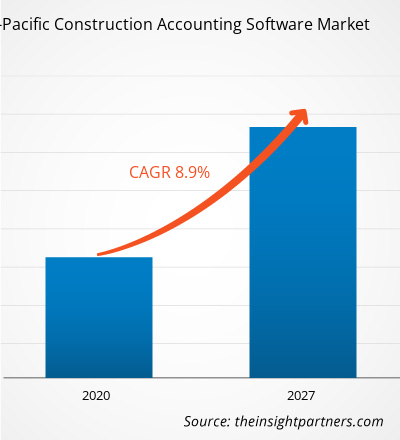The construction accounting software market in APAC is expected to grow from US$ 201.98 million in 2019 to US$ 384.38 million by 2027; it is estimated to grow at a CAGR of 8.9% from 2020 to 2027.
Australia, India, China, Japan, South Korea are major economies in APAC. ERP modules increasing their invasion in construction industry has witnessed growth in recent years which is driving the APAC construction accounting software market. Building information management (BIM) has steadily become a priority among engineering and construction businesses. In some markets, mainly in India it is basically supporting the Government Construction Strategy, where acquirement rules for projects may be renewed. There has been a transition towards building minimum levels of BIM mandatory to avail tender in government-funded construction projects. This compulsion to move to a greater level of the agreement will only intensify in the future, the adoption of BIM. For companies in the engineering and construction business, acknowledging ERP or enterprise asset management (EAM) and project management preferences has become utmost important. For organizations in the engineering and construction market, considering ERP or enterprise asset management (EAM) and project management preferences, these trends promote an integrated approach's importance. Construction accounting software can be simply integrated with ERP modules. As more of the large construction companies are considering ERP modules for a more conventional flow of their business, the requirement for construction accounting software is also set to expand, which is further anticipated to drive the market in APAC.
Further, the ongoing COVID-19 is causing havoc in APAC region. The APAC is characterized by the presence of a large number of developing countries, positive economic outlook, high industrial presence, and a huge population. The high growth rate of urbanization and industrialization in developing countries of the region is anticipated to offer ample growth opportunities to the market players operating in the construction accounting software market, as the investments in advanced technologies development are quite high in the region. According to the Organization for Economic Co-operation and Development (OECD), the other major economies outside of China have also impacted by the pandemic, such as huge India, South Korea, Australia, and Japan. China and India are among the worst-affected COVID-19 countries in the region, as well as in the world. The governments are taking drastic measures to reduce the effects of coronavirus outbreak by announcing lockdowns, travel, and trade bans. The construction sector in the countries mentioned above have been experiencing less building activities and a weak supply chain. Additionally, the labor shortage has affected the construction sector in these countries. The construction companies are foreseen to revive substantial development of infrastructures by 2021, which is anticipated again to create demand for construction accounting software. This, in turn, is expected to have positive impact on the construction accounting software market in the coming years.
With the new features and technologies, vendors can attract new customers and expand their footprints in emerging markets. This factor is likely to drive the APAC construction accounting software market. The APAC construction accounting software market is expected to grow at a good CAGR during the forecast period.
APAC Construction Accounting Software Market

- This FREE sample will include data analysis, ranging from market trends to estimates and forecasts.
APAC Construction Accounting Software Market Segmentation
APAC Construction Accounting Software Market – By Component
- Solutions
- Services
APAC Construction Accounting Software Market – By Deployment Type
- Cloud
- On-Premises
APAC Construction Accounting Software Market – By Application
- SMEs
- Large Enterprises
APAC Construction Accounting Software Market, by Country
- Australia
- China
- India
- Japan
- South Korea
- Rest of APAC
APAC Construction Accounting Software Market - Companies Mentioned
- Chetu Inc.
- Intuit Inc.
- Sage Group plc
- Viewpoint, Inc.
- Xero Limited
Asia-Pacific Construction Accounting Software Report Scope
| Report Attribute | Details |
|---|---|
| Market size in 2019 | US$ 201.98 Million |
| Market Size by 2027 | US$ 384.38 Million |
| Global CAGR (2020 - 2027) | 8.9% |
| Historical Data | 2017-2018 |
| Forecast period | 2020-2027 |
| Segments Covered |
By Component
|
| Regions and Countries Covered | Asia-Pacific
|
| Market leaders and key company profiles |
- Historical Analysis (2 Years), Base Year, Forecast (7 Years) with CAGR
- PEST and SWOT Analysis
- Market Size Value / Volume - Global, Regional, Country
- Industry and Competitive Landscape
- Excel Dataset



Report Coverage
Revenue forecast, Company Analysis, Industry landscape, Growth factors, and Trends

Segment Covered
Component, Deployment Type, and Application

Regional Scope
North America, Europe, Asia Pacific, Middle East & Africa, South & Central America

Country Scope
Australia, China, Japan, South Korea
Trends and growth analysis reports related to Technology, Media and Telecommunications : READ MORE..
- Chetu Inc.
- Intuit Inc.
- Sage Group plc
- Viewpoint, Inc.
- Xero Limited

 Get Free Sample For
Get Free Sample For